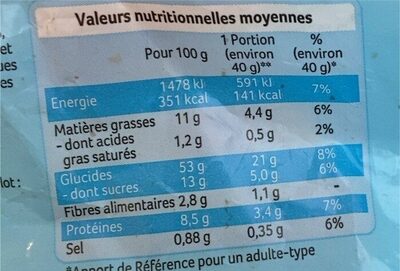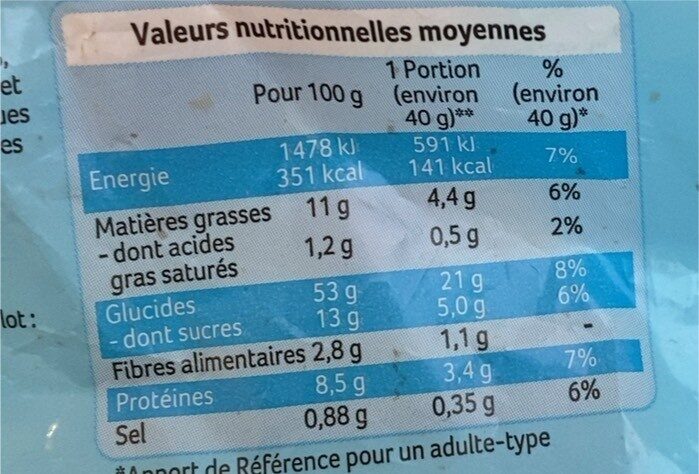10 pains au lait - Les PâtissadesAldi - 400 g
Ambiguous barcode: This product has a Restricted Circulation Number barcode for products within a company. This means that different producers and stores can use the same barcode for different products.
×
This product page is not complete. You can help to complete it by editing it and adding more data from the photos we have, or by taking more photos using the app for Android or iPhone/iPad. Thank you!
×
Barcode: 26073651
Common name: Pain au lait aux œufs frais
Quantity: 400 g
Packaging: Clip souple métal plastique, fr:Sachet plastique
Brands: Les PâtissadesAldi
Categories: Snacks, Sweet snacks, Sweet pastries and pies, Viennoiseries, Milk bread rolls, Aliments d'origine végétale, Aliments et boissons à base de végétaux, Céréales et pommes de terre, Pains, Pains au lait, Pains-au-lait-aux-oeufs-frais, Petit-déjeuners, Snacks sucrés
Labels, certifications, awards:
Green Dot, Made in France, Eco-Emballages
Manufacturing or processing places: La Fournée Dorée Atlantique (LFDA) - ZA Sud des Achards - 85150 La Chapelle-Achard, Vendée, Pays de la Loire, La Fournée Dorée (LFD) - Rue de Champelle - ZA Haute Choux - 57255 Sainte-Marie-aux-Chênes, Moselle, Lorraine, France
Traceability code: EMB 85052 - Chapelle-Achard (Vendée, France), EMB 57620A - Sainte-Marie-aux-Chênes (Moselle, France)
Stores: Aldi
Matching with your preferences
Environment
Carbon footprint
Packaging
Transportation
Report a problem
Data sources
Product added on by jacob80
Last edit of product page on by smoothie-app.
Product page also edited by date-limite-app, ecoscore-impact-estimator, feat, halal-app-chakib, harragastudios, inf, kiliweb, openfoodfacts-contributors, packbot, quechoisir, roboto-app, tacite, tacite-mass-editor, yuka.U3Jva0FvOWRsL3dWaXRnd3BDSGF5TndyK2FhMkEyMnFMODVPSUE9PQ, yuka.VDQ5WUhyMHZuZk1nbHZROTd4Zm9xNDh1K0pXUFlVaU5NUG9VSWc9PQ, yuka.WXB3eU5ma3VuOWNVcDhNaHB4bnYyTTBzbjgvMVRHV21DcnM3SUE9PQ, yuka.Wkl3dUNmMWNvdUlqZ2ZRUy9rLzQrc05rMnNHalozbVZOTWtWSWc9PQ, yuka.YjY0T0NQUWNvdUkxcDhCbndrenJ4ZFZ3MmJXMGQwQ3NkKzRqSVE9PQ, yuka.Ykp0UVRxZ1luTmc2aC9BRHdndjM1dk51NTdTdGNtKzVJZGRCSUE9PQ, yuka.sY2b0xO6T85zoF3NwEKvlkFoSoLBqWP9LCzmxEiAnoaiJ8zmf-14wLTHNqg, yuka.sY2b0xO6T85zoF3NwEKvlkdFQ_3kvSPaGBPVokSWmtSAd73kWchi2prcAqs, yuka.sY2b0xO6T85zoF3NwEKvllBlTITVhh3YLELSn1CE-dGjNY7ped1w8pf5Iqs, yuka.sY2b0xO6T85zoF3NwEKvlm5gf9mErzjNGzDvn1-6xcmCcb3rasxJvdHQMqs, yuka.sY2b0xO6T85zoF3NwEKvlmAYcPPEmD7mDizhsEimzNS2MYXqWNtQ6Y_ZY6s, yuka.sY2b0xO6T85zoF3NwEKvlmFod_fU-zeZCz_huGGX_o7QHpjmRtJQvYjGDas, yuka.sY2b0xO6T85zoF3NwEKvlnBtc9znpyvpHQXVixPW54euf5bNMPBc-KHjGas.






